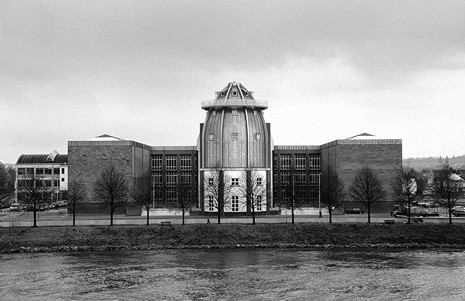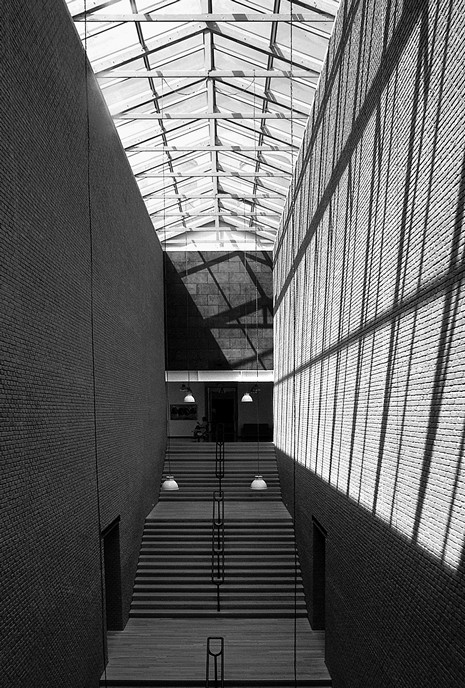Description
In what used to be an industrial estate on the banks of the Maas, across from the old town of Maastricht, the Bonnefanten Museum is the first identity-promoting building in the new city quarter planned by renowned architects. In strict typology, Aldo Rossi designed a symmetrical building on an E-shaped ground plan; its three wings include two rectangular courtyards that open toward the Maas as prescribed in the brief. The silhouette of the extended museum layout, visible from across the river and beyond, is dominated by a cupola-crowned tower which, being whitewashed on the bottom with its upper part clad in sheet zinc, not only builds material aesthetic suspense to the brickwork of the rest of the building, but also awakens associations that range from homage to the erstwhile industrial site to a lighthouse. According to Rossi, it is to serve as “an identification signal and turning point in time.”
However, the entrance to the museum lies in the massive central projection of the façade facing away from the river. A steel portal leads from there into the four-storey-high foyer into which daylight cascades through a round opening in the ceiling that has the appearance of an upturned funnel because of the recessing of the walls from one storey to the next. From the deepest-placed point of light incidence, the ascent begins via an enormous stairway, six metres wide and as long as the building is deep, to the huge white domed room, its antipode in the striking round tower. (Rossi had actually intended to make the visitors themselves into the focus point of the light at the end of the ascent to the viewing terrace, no longer accessible today.) The ascent from the nadir to the zenith, canalized between brick walls the height of the building does not only effectively convey a sense of urgency, but also serves a practical purpose for access to the clearly organized exhibition rooms that form a very usable and unpretentious ambience for the large but disparate collection. On the second floor, these rooms are lit by natural light from above, while on the first floor, they have lateral lighting supplemented by artificial illuminated ceilings.
Museo d’arte e architettura, exhibition catalogue, Lugano, 1992, pp. 142-149 • Domus 762/1994, pp. 7-22 (Aldo Rossi) • Baumeister 9/1994, pp. 34-39 (Arthur Wortmann) • Bauwelt 3/1995, pp. 118-125 (Carl Friedrich Schröer) • Deutsche Bauzeitschrift 8/1995, pp. 92-93 (W. Töpfer) • Alberto Ferlenga, Aldo Rossi. Opera completa 1993-1996, Milan, 1995, pp. 17-27 • Bonnefantenmuseum, Maastricht, 1996 • Luca Basso Peressut, musei. architetture 1990-2000, Milan, 1999, pp. 92-103 • Vittorio Magnago Lampugnani/Angeli Sachs (eds.), Museums for a New Millennium, Munich/London/New York, 1999, pp. 108-115 • Frank Maier-Solgk, Die neuen Museen, Cologne, 2002, pp. 166-173
Drawings
Ground floor
Second floor
Third floor
Fourth floor
Longitudinal section through the central wing
Elevation
Photos

View from across the Maas river

View of the main staircase
Originally published in: Paul von Naredi-Rainer, Museum Buildings: A Design Manual, Birkhäuser, 2004.